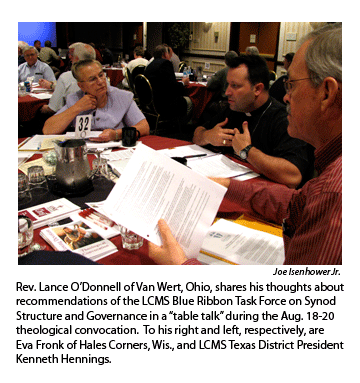By Joe Isenhower Jr.
Strengthening congregations’ mission and ministry is a major point of preliminary proposals offered by the Blue Ribbon Task Force on Synod Structure an
Made public at the end of the Synod’s Aug. 18-20 theological convocation in St. Louis, the proposals are available for reading and download in PDF format from the LCMS Web site, www.lcms.org. At that site, click on the tab with the
leaf-outlined cross titled “Walking Together — Task Force on Synod Structure and Governance,” and then on the document named “Walking Together — The LCMS Future: Proposals and Possibilities for Consideration and Discussion” under “Discussion Documents.”
The task force Web page also has a “Frequently Asked Questions” feature and tabs for press releases and reports.
To view a video with members of the task force providing background information along with the preliminary recommendations, click on the same tab at the Synod home page, then on “Video” under the “Other Resources” heading.
“The future of The Lutheran Church–Missouri Synod lies within a spiritually strong congregational mission and ministry of Word and Sacrament,” LCMS President Gerald B. Kieschnick says in the video. “The focus of our church body must be on renewing the health and vitality of existing churches and starting new congregations — communities of faith characterized both by faithful adherence to God’s Word and also by disciple-making, baptizing, and teaching.”
“The time is right in our church body to find ways of improving the way we support congregations, lay leaders, pastors, and commissioned ministers in accomplishing the mission God has given,” Kieschnick continues in the video.
“We need structure and governance that are flexible and forward looking — receptive to new opportunities God is giving the Synod,” he says. “And we need a Synod that can help us maximize limited resources as faithful stewards, particularly in the current economic climate of our nation.
“That’s the reason I appointed the Blue Ribbon Task Force on Synod Structure and Governance,” Kieschnick emphasizes in the video shot at Trinity Lutheran Church in St. Louis — one of 14 congregations that formed the Synod in 1847, and the site of the convocation Communion service Aug. 19.
“The following proposals/possibilities are not final by any means,” an introductory section of the “Walking Together — The LCMS Future” document states. “With the expectation of feedback,” it continues, “the Synod’s members and leaders are participating as valued and active partners in this work-in-progress.
Focus on principles
“In order to advance Christ’s mission,” the introduction reads, “it has been the intent of the task force that all the proposals/possibilities be aligned with the Synod’s theological principles, such as those discussed in the task force document Congregation — Synod — Church.” That document is available in PDF format at www.lcms.org?11678.
Those 22 basic principles provided the focus for the theological convocation.
Task force Chairman Robert Greene announced to the convocation Aug. 20 the availability of an e-mail address, lcmsfuture@lcms.org, for “anyone in the Synod to provide feedback and recommendations” concerning the preliminary proposals.
In his remarks to the 250-some gathered for the convocation — which had as its theme “Carrying Out God’s Mission in the 21st Century: The Relationship between Theology and Polity” — Greene said t
Convocation participants discussed the preliminary proposals in “table-talk” settings that resulted in questions and comments for the task force.
“The record of your table-talk discussions will be collected, reviewed, studied, and considered for incorporation as [the task force] continues this work-in-progress,” Greene told the convocation participants.
Leading up to the Synod’s 2010 convention in Houston — which is expected to consider final recommendations for the Synod’s future structure and governance — the task force will discuss its preliminary proposals with each of the 35 LCMS districts’ boards of directors before further refining them for next year’s district conventions, as well as for a number of regional caucuses of delegates to the 2010 Synod convention.
“I felt that the convocation did what we wanted it to do — namely, to cast the discussion for the task force proposals into a theological setting,” Dr. Samuel H. Nafzger told Reporter.
Installed as the Synod’s first director of Church Relations — assistant to the president during the Aug. 19 Communion service, Nafzger is a member of the task force and served on the convocation planning committee. He is former executive director of the LCMS Commission on Theology and Church Relations (CTCR).
In an interview for last month’s Reporter, Nafzger said that between the convocation and the 2010 convention, the task force would “seek to build consensus throughout the Synod.”
“If we can carry out the discussion about these proposals from the task force on the basis of our theological principles,” he said following the convocation, “then in some ways how we go about carrying out this discussion will be at least as important as the proposals that are finally adopted. Then the adopted proposals will simply streamline this ship called The Lutheran Church–Missouri Synod to carry out with efficiency and effectiveness the mission that God has given us to do.”
Nafzger stressed that he “want[s] to emphasize” what he said in his keynote address for the convocation: “As important as the polity of the Synod is for helping us get on with the carrying out of God’s mission, simply tinkering with the Synod’s structure and governance will not enable it to address and meet successfully and faithfully the most serious challenges which we as the Synod face today. We must first of all, to use the words of the task force itself, ‘identify, review, and reconnect ourselves’ to those principles that

